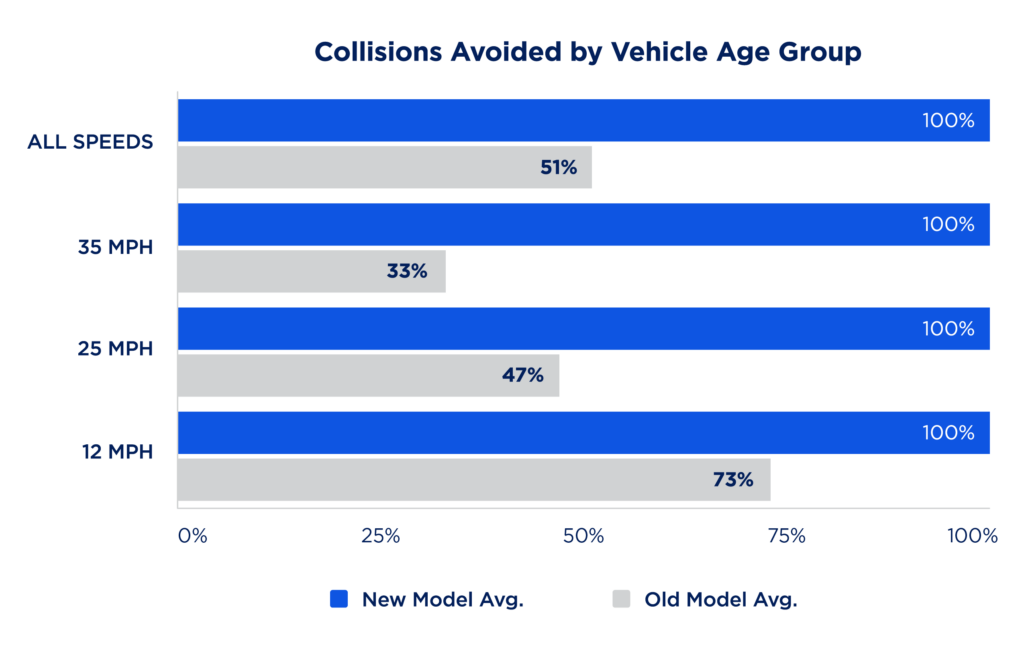Tech
Out with the Old (Automatic Emergency Braking), In with the New

ORLANDO, Fla. (Oct. 24, 2024) – AAA’s latest research found that new (2024) model vehicles with automatic emergency braking (AEB) avoided 100% of forward collisions when tested at speeds up to 35 mph, in comparison to old (2017 – 2018) model vehicles, which only avoided collisions 51% of the time. AEB uses forward-facing cameras and other sensors to automatically tell the car to apply the brakes when a crash is imminent. Most new vehicles are equipped with AEB, but earlier this year, the National Highway Traffic Safety Administration (NHTSA) issued a new Federal Motor Vehicle Safety Standard (FMVSS) requiring automakers to include AEB in their vehicles by 2029.
“Since we began testing AEB in 2014, the advancements by automakers are commendable and promising in improving driver safety,” said Greg Brannon, director of automotive engineering research. “There is still significant work ahead to ensure the systems work at higher speeds.”
Over the last decade, AAA has evaluated various advanced driver assistance systems, including AEB, to determine if the technology performs as expected. While these systems continue to be refined with upgraded software and sensors, AAA wanted to see if AEB functionality has improved when compared to older versions.
Background
AAA, in partnership with the Automobile Club of Southern California’s Automotive Research Center, conducted research in a closed-course, simulated environment to evaluate the performance progression of AEB systems on older model vehicles (2017 – 2018) compared to new (2024). Old and new test vehicles of the same make and model were evaluated at three common speeds (12 mph, 25 mph, and 35 mph) to see how well they performed in a forward collision. Learn more from the full report.
Results
New model vehicles (2024) were nearly twice as likely to avoid a collision as older model vehicles (2017 – 2018) when tested at speeds up to 35 mph, which aligns with current safety standards requiring AEB to work up to this same speed.

Conclusion
Based on these results, the progression of AEB systems in vehicles demonstrates substantial improvement over time. The newest models were capable of avoiding potential collisions altogether at slower speeds. This improvement in AEB technology is a promising development that significantly reduces the risk of collisions on the road. As car manufacturers continue to enhance these systems, can the public expect even higher levels of safety and reliability? AAA will continue to monitor these developments as well as other changes to regulations.
Driver Advice:
- The progression of these systems is improving and performing as intended. Having these systems in your vehicle can help prevent collisions.
- Never rely solely on technology to apply the brakes. AEB systems are not a replacement for an attentive driver.
- Be aware of the limitations of an AEB system and stay engaged while driving. Maintain focus, even when driving vehicles equipped with advanced safety features.
- Engaging in risky driving behaviors such as speeding, texting, driving while drowsy or distracted, or driving under the influence of cannabis or alcohol significantly increases the risk of a collision. Remember to stay alert! Follow speed limits, keep your smartphone out of reach, and only drive when sober.
What happens at higher speeds?
According to data collected by the Federal Highway Administration (FHWA), a majority of total miles driven in the U.S. occur at higher speeds (above 35 mph). AAA engineers added test scenarios to assess the limits of current AEB systems at higher speeds. Three out of four vehicles evaluated avoided a 45-mph collision. For those vehicles that avoided a collision at 45 mph, the test speed was increased to 55 mph. None of the remaining test vehicles avoided a collision at 55 mph.

Bottom Line:
These findings highlight the importance of continued AEB improvements. A NHTSA rule released earlier this year requires new vehicles to avoid a forward collision at speeds up to 62 mph by 2029.
Encouraged by the new NHTSA ruling, AAA offers the following advice to industry:
- Continued Development of Advanced AEB Systems: Automakers should prioritize developing AEB systems for high-speed scenarios like those in the new FMVSS 127. These systems have already displayed significant efficacy in preventing collisions up to 35 mph.
- Enhance Forward Collision Warning (FCW) Alerts: If FCW systems offer earlier alerts, they can provide drivers with additional reaction time, decreasing the sole reliance on AEB systems. This approach can establish a more cooperative safety mechanism where both the driver and the vehicle collaborate to prevent collisions.
- Research and Development for High-Speed Scenarios: Ongoing investment in research and development is crucial for improving the effectiveness of AEB systems at higher speeds. This involves advancing sensor technologies, optimizing braking algorithms to minimize false positives, and undertaking comprehensive real-world testing to meet updated regulatory requirements and guarantee safety at higher speeds.
Methodology
In partnership with the Automobile Club of Southern California’s Automotive Research Center, AAA tested early and late model vehicles from the same automaker evaluated back-to-back on the same day to eliminate any testing bias. Vehicles were driven on a closed-course roadway with a DRI Soft Car 360® positioned at the end of the course, with the rear facing the subject vehicle. Please refer to the full report for details on the methodology, including specific testing equipment and test track characteristics.
About AAA
Started in 1902 by automotive enthusiasts who wanted to chart a path for better roads in America and advocate for safe mobility, AAA has transformed into one of North America’s largest membership organizations. Today, AAA delivers exceptional roadside assistance, helps travelers plan their dream vacations and adventures, offers exclusive member discounts and benefits, and provides trusted financial and insurance services – all to enhance the life journey of our 65+ million members across North America, including over 57 million in the United States. To learn more about all AAA offers or become a member, visit AAA.com.









